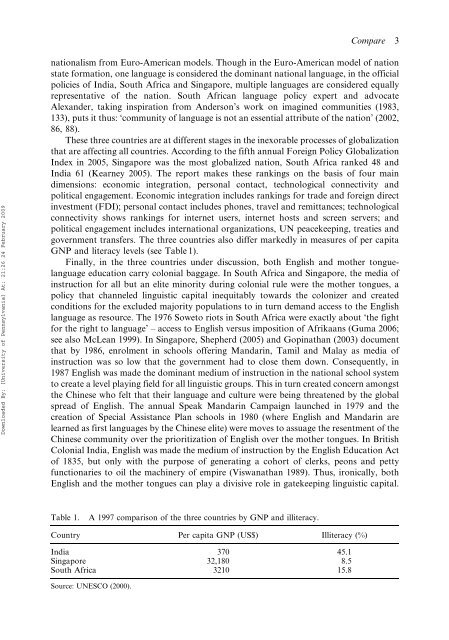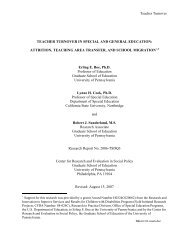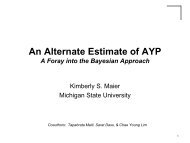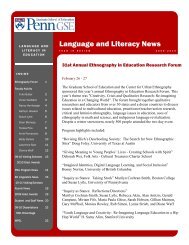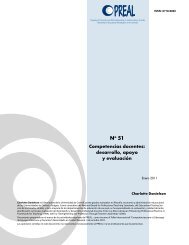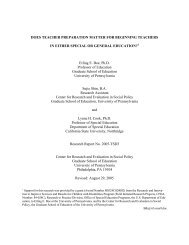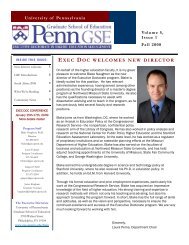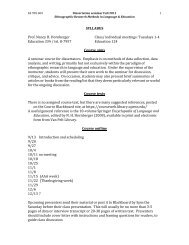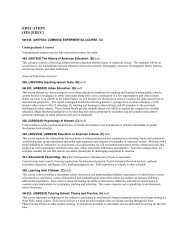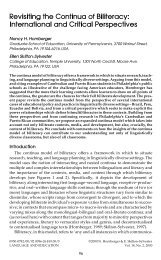Multilingual language policy and school linguistic practice
Multilingual language policy and school linguistic practice
Multilingual language policy and school linguistic practice
Create successful ePaper yourself
Turn your PDF publications into a flip-book with our unique Google optimized e-Paper software.
Compare 3<br />
Downloaded By: [University of Pennsylvania] At: 21:26 24 February 2009<br />
nationalism from Euro-American models. Though in the Euro-American model of nation<br />
state formation, one <strong>language</strong> is considered the dominant national <strong>language</strong>, in the official<br />
policies of India, South Africa <strong>and</strong> Singapore, multiple <strong>language</strong>s are considered equally<br />
representative of the nation. South African <strong>language</strong> <strong>policy</strong> expert <strong>and</strong> advocate<br />
Alex<strong>and</strong>er, taking inspiration from Anderson’s work on imagined communities (1983,<br />
133), puts it thus: ‘community of <strong>language</strong> is not an essential attribute of the nation’ (2002,<br />
86, 88).<br />
These three countries are at different stages in the inexorable processes of globalization<br />
that are affecting all countries. According to the fifth annual Foreign Policy Globalization<br />
Index in 2005, Singapore was the most globalized nation, South Africa ranked 48 <strong>and</strong><br />
India 61 (Kearney 2005). The report makes these rankings on the basis of four main<br />
dimensions: economic integration, personal contact, technological connectivity <strong>and</strong><br />
political engagement. Economic integration includes rankings for trade <strong>and</strong> foreign direct<br />
investment (FDI); personal contact includes phones, travel <strong>and</strong> remittances; technological<br />
connectivity shows rankings for internet users, internet hosts <strong>and</strong> screen servers; <strong>and</strong><br />
political engagement includes international organizations, UN peacekeeping, treaties <strong>and</strong><br />
government transfers. The three countries also differ markedly in measures of per capita<br />
GNP <strong>and</strong> literacy levels (see Table 1).<br />
Finally, in the three countries under discussion, both English <strong>and</strong> mother tongue<strong>language</strong><br />
education carry colonial baggage. In South Africa <strong>and</strong> Singapore, the media of<br />
instruction for all but an elite minority during colonial rule were the mother tongues, a<br />
<strong>policy</strong> that channeled <strong>linguistic</strong> capital inequitably towards the colonizer <strong>and</strong> created<br />
conditions for the excluded majority populations to in turn dem<strong>and</strong> access to the English<br />
<strong>language</strong> as resource. The 1976 Soweto riots in South Africa were exactly about ‘the fight<br />
for the right to <strong>language</strong>’ – access to English versus imposition of Afrikaans (Guma 2006;<br />
see also McLean 1999). In Singapore, Shepherd (2005) <strong>and</strong> Gopinathan (2003) document<br />
that by 1986, enrolment in <strong>school</strong>s offering M<strong>and</strong>arin, Tamil <strong>and</strong> Malay as media of<br />
instruction was so low that the government had to close them down. Consequently, in<br />
1987 English was made the dominant medium of instruction in the national <strong>school</strong> system<br />
to create a level playing field for all <strong>linguistic</strong> groups. This in turn created concern amongst<br />
the Chinese who felt that their <strong>language</strong> <strong>and</strong> culture were being threatened by the global<br />
spread of English. The annual Speak M<strong>and</strong>arin Campaign launched in 1979 <strong>and</strong> the<br />
creation of Special Assistance Plan <strong>school</strong>s in 1980 (where English <strong>and</strong> M<strong>and</strong>arin are<br />
learned as first <strong>language</strong>s by the Chinese elite) were moves to assuage the resentment of the<br />
Chinese community over the prioritization of English over the mother tongues. In British<br />
Colonial India, English was made the medium of instruction by the English Education Act<br />
of 1835, but only with the purpose of generating a cohort of clerks, peons <strong>and</strong> petty<br />
functionaries to oil the machinery of empire (Viswanathan 1989). Thus, ironically, both<br />
English <strong>and</strong> the mother tongues can play a divisive role in gatekeeping <strong>linguistic</strong> capital.<br />
Table 1.<br />
A 1997 comparison of the three countries by GNP <strong>and</strong> illiteracy.<br />
Country Per capita GNP (US$) Illiteracy (%)<br />
India 370 45.1<br />
Singapore 32,180 8.5<br />
South Africa 3210 15.8<br />
Source: UNESCO (2000).


